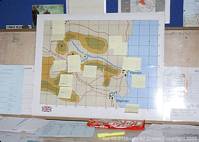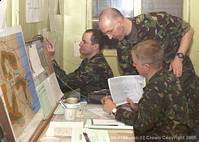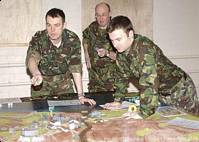Greece 1941, Officer Training Exercise, RAF Lossiemouth, UK
Over 28 Feb and 1 Mar 05 a number of Royal Air Force Officers and NCOs were exposed to wargaming in a successful training exercise. In the cavernous hall of the new RAF Regiment Flight at RAF Lossiemouth (it really is big, but once the stud walls are in it will be two lecture rooms and a corridor) they gathered with a certain amount of intrigue, but probably a little more trepidation. One end of the hall had been set up as a lecture room, the other with three 6'x6' wargames tables and an area for the umpires. The troops gravitated towards the tables, muttering about what was ahead. A few waited more centrally, gathering around the display boards that had been used to divide the room - which, rather ominously, were covered in pictures of mine effects and other dire warnings for operational deployment training.
As the lessons started, the 20 picked men reluctantly moved away from the tables and took their seats. Doctrine, military decision making processes, the estimate - the first day wore on, at every break they drifted back to look at the tables and the two 750pt armies being laid out ready for a demonstration in the afternoon. After lunch it became more lively. A practical exercise in fitting the estimate to D-Day started to set the scene for WW2. Then an introduction to the concept of using three wargames, with two isolated HQs, to exercise their understanding of the estimate, their communication and their planning ability. Interest started to develop, although there was a certain amount of confusion over what exactly a wargame was.
Their baptism of, dice borne, fire came at two in the afternoon. The heavy theory sessions out of the way, they were introduced to BlitzkriegCommander (BKC). As a simple set of rules, which allow different vehicles and units to have different effects, BKC was chosen for the game supporting this training aid. The speed with which people took to the rules varied, indeed some were obviously experienced (albeit closet) wargamers and some found it hard to grasp the concept. Yet by the end of the day enough had had a go for us to feel confident about the next day.
1 Mar 05 saw us return to Greece in the Spring of 1941. The British and Greeks have been defeated, the majority of British troops have been evacuated by the RN, the Germans are trying to complete their control of the rural areas. Near the port of Diginovi, British 3 Corps have been cut off and are preparing to be taken off. The pressure is light, but building, as the Germans push to prevent the escape of this formation.
The, now eager, students were split into their camps and given appointments within the chain of command - from a divisional command staff of four, down to the Brigade commanders and their deputies at the tables. The divisional commanders were given their orders and were then allowed three hours to utilise the decision making processes they had been taught to develop a plan. Two very different approaches emerged - the British came up with a concept, then planned around it. The Germans planned until they ran out of time and then developed a concept!
As battle was joined the British defenders were arrayed across the three boards, their Air Forces (tasked by the Div commanders and operating out of sight) began their tussle for command of the skies. Actually the Germans left theirs sat on the ground until they could find something to do with them, whilst the British launched a heavy raid against the German airfield. After losing a flt of Stukas and having their Heinkels and some more Stukas damaged the Germans did.... nothing actually. Their air officer had gone to get himself some lunch, leaving pretty timelines and lists of targets in the German HQ which left them thinking they had an air campaign in progress! The Germans also had problems getting their troops from Larimissa to the front line, as they had chosen to send nine battalions of troops down a single road, at the same time, with no priorities! An irate umpire, sorry - traffic duty feldgendamarie - called the divisional HQ and eventually restored order - having done just enough to mess up the order of march and delay the arrival of some units by 45 minutes (three turns in game time).
In the East, the quiet fishing village of Parmoli was on the receiving end of a motor cycle battalion. Considering it had a battalion of NZ infantry, two troops of 40mm Bofors, a battery of 25pdrs and a Sqn of Cruiser tanks it was a bit one sided, but the motor cycle battalion was only the advance guard. Later, the Panzer Grenadiers started to arrive. The strange thing was, this was intended as a fixing action, but the German Div Command, acting on the increasingly worried calls of their Bde Commander, nearly called it off. The German Bde Commander had a third of his motorcycle battalion and only the HQ and recce for his Panzer Grenadiers and had lost two units of infantry in motorbikes (representing about two platoons). His fears for his force grew rapidly, being communicated by field telephone to the Div Commander! Eventually, the combined strength of the two battalions would force the British to fall back on their open flank, although remaining anchored in the village.
Towards the Western end of the British line the Italians clashed with the Prince Of Wales own Regiment of Yorkshire... and stopped dead in their tracks. Their complete inability to give orders to their subordinates, combined with constant British air attacks (unharried by the Luftwaffe) resulted in the Bde commander issuing orders direct to the platoons - probably whilst he sent an aide with a pistol loaded with one shot to each of the Italian Battalion commanders! This end of the line remained unthreatened throughout the day, but saw significant use of British air power, probably wasted due to the fact that the Italians were outnumbered by the dug in, well sited defenders.
In the centre, in the foothills and valleys of the region, the British Greek allies waited. Only after they had been placed did anyone realise that the Greeks had artillery, but no FOOs (the TO&Es had deliberately been constructed to ensure they had to be used intelligently, without deviating too far from history). Remaining unconcerned, after all the Germans wouldn't come this way (would they). British Race flits, in Spitfires, picked up both of the enemies artillery units moving to the Eastern and Western battlefield, but missed a large force of Panzers (two battalions and a battalion of motorised infantry) leaving the road in the centre. Mid morning (game time - actually early afternoon) key pieces of equipment started to show up on the centre table - Panzer 2s (indicating a Lt Panzer Battalion), Panzer 4s (medium battalion) and Sdkfz 222s (Motorised infantry) - the weak Greek force was isolated and facing three strong battalions. As if to make matters worse, the Luftwaffe finally got airborne in strength and headed for some close air support. Little lasting damage was done, only one unit of Greeks destroyed in the Maelstrom - it just happened to be the battalion commander. Leaving the Bde Commander to control units over a six foot front, with no FOO to call for artillery support. The Germans continued to arrive, calls for British air went unheeded as they tried to concentrate on the Panzer Grenadiers.
As the fourth battalion of Germans arrived to overwhelm the Greeks, the British committed their reserve and switched the attentions of the Royal Air Force to the centre. A last turn which saw four flts of German aircraft achieve very little against the dispersed and dug in Greeks, but which saw the closely packed Germans take grievous (but in those numbers insignificant) casualties.
As we called it to an end, not because it had finished, but because the training was complete, there were quite a few individuals who wanted to go back and finish their battles. The measure of the success is that we have been asked to run more of these, albeit with a few alterations to allow the two days to flow more smoothly into each other! The other measure of success (not one I'm worried about in my official capacity) is that several closet wargamers have 'come out' and several non-wargamers are a little more open to the concept.
Thanks to Minifigs - they got the toys to us in plenty of time, TimeCast - for the lovely buildings, EM4 - for fulfilling such a large dice order near Christmas and Pete - for writing BKC. Oh, and thanks to the RAF for giving me some holding officers to get it all ready in time!



© Crown Copyright 2005